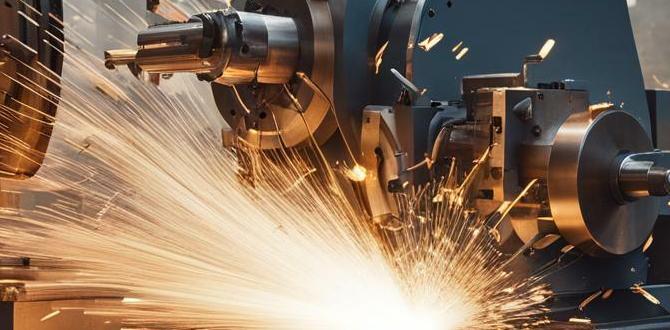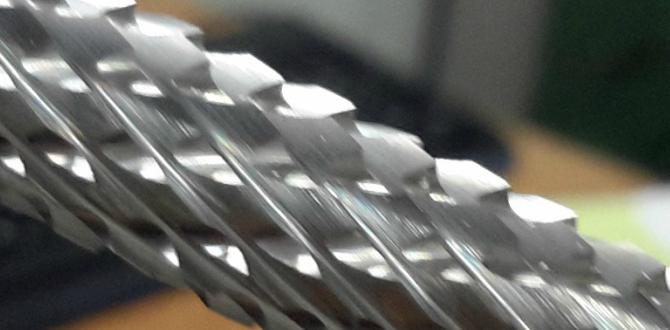Carbide tips for lathe tools are small, incredibly hard inserts that significantly improve cutting performance, tool life, and efficiency. This guide teaches beginners how to choose, use, and maintain them for better machining results.
Hello fellow makers and tinkerers! Ever feel like your lathe tools just aren’t cutting as smoothly or as long as you’d like? Maybe you’re spending too much time sharpening or dealing with frustrating tool wear. You’re not alone! This is a common hurdle for many starting out with metal or woodworking lathes. The good news? There’s a brilliant solution that can transform your machining experience: carbide tips for lathe tools. They might seem a bit technical at first, but once you understand them, they become your secret weapon for cleaner cuts and less hassle. We’re going to break down everything you need to know, step-by-step, so you can start using them with confidence. Stick around, and let’s make your lathe work smarter!
What Are Carbide Tips For Lathe Tools?
At their core, carbide tips for lathe tools are precisely shaped inserts made from a super-hard material called cemented carbide. Think of them as tiny, replaceable cutting edges designed to tackle tough materials and high-speed cutting like a champ. Unlike traditional tool bits that are ground from a single piece of high-speed steel (HSS), carbide inserts are usually brazed or screwed onto a steel tool body. This design offers major advantages for anyone using a lathe, whether for detailed metalwork or robust woodworking.
Why Are They So Special? The Magic of Cemented Carbide
The secret ingredient is cemented carbide itself. This remarkable composite material is made by pressing a mixture of fine tungsten carbide powder and a softer metal binder (typically cobalt) into a desired shape, then sintering it at a very high temperature. This process fuses the particles together, creating an incredibly hard and wear-resistant material.
Here’s what makes cemented carbide a game-changer:
Extreme Hardness: Carbide is significantly harder than high-speed steel. This means it can cut harder materials and maintain its sharp edge for much longer.
High Heat Resistance: Carbide can withstand the high temperatures generated during cutting without softening, allowing for faster cutting speeds.
Wear Resistance: Its hardness translates to superior resistance against abrasion and wear, leading to longer tool life.
These properties mean that with carbide inserts, you can often cut faster, achieve a better surface finish, and make more parts before needing to replace or regrind your cutting edge.
The Many Benefits of Using Carbide Tips
Switching to carbide tips isn’t just about having a fancier tool; it brings tangible improvements to your workshop. For beginners, these benefits can make a huge difference in learning and producing quality work.
Pros: What You Gain
Extended Tool Life: This is perhaps the biggest win. Carbide edges stay sharp many times longer than HSS, reducing the frequency of tool changes and sharpening.
Improved Surface Finish: The sharpness and rigidity of carbide inserts often result in smoother, cleaner cuts on your workpiece.
Faster Cutting Speeds: Their heat and wear resistance allow you to increase your spindle speed and feed rate, significantly speeding up your machining time.
Ability to Cut Harder Materials: If you work with difficult metals like stainless steel or hardened steel, carbide is often the only practical choice.
Cost-Effectiveness (Long Term): While the initial cost might seem higher, the extended life, reduced downtime, and improved efficiency often make carbide cheaper in the long run.
Consistent Performance: Because you can simply replace a dull insert rather than regrind an entire tool bit, you maintain a consistent cutting geometry and performance.
Versatility: Carbide inserts come in many shapes and grades for different applications, making them adaptable to various tasks.
Cons: What to Consider
Brittleness: The extreme hardness that makes carbide so great also makes it brittle. It can chip or break if subjected to shock loads, sudden impacts, or if misused.
Higher Initial Cost: A set of carbide insert tooling can be more expensive upfront than a basic set of HSS tool bits.
Requires Proper Tool Holders: You can’t just insert a carbide tip into any tool post; you need specific tool holders designed to accept them.
Grinding Challenges: While you can buy pre-shaped inserts, if you ever need to grind a carbide blank (less common for beginners), it requires specialized diamond grinding wheels.
Potential for Chatter: If not used correctly or if the setup is not rigid, the insert can be more prone to causing vibration (chatter) due to its hardness.
Types of Carbide Inserts: Finding the Right Fit
Carbide inserts aren’t one-size-fits-all. They come in a dizzying array of shapes, sizes, and grades designed for specific tasks. Understanding these differences will help you choose the right ones for your lathe work.
Insert Shapes: The Geometry of Cutting
The shape of the insert is crucial as it dictates its application. Here are some common ones you’ll encounter:
Square (SNMG, SNGP, SNUN): Very versatile, used for general turning, facing, and profiling. The 90-degree corners are great for square shoulders.
Round (RPGT, RCMT): Excellent for finishing operations and taking deep cuts without digging in. Their rounded shape helps prevent chatter.
Trigon (TNGM, TNMG): Triangular shape with 80-degree corners. Good for general-purpose turning and for getting close to chucks or fixtures.
Diamond (DCMT, DCGT): Often used for specific profiling and threading. They come in various included angles (e.g., 55 degrees, 80 degrees).
Rhombic (CCMT, CNMG): Similar to diamond but often with different clearance angles, used for general turning and facing.
The number and letter codes in the insert designation (like SNMG) refer to specific geometric features, such as shape, clearance angle, and hole type. Don’t worry too much about memorizing these codes initially; focus on the basic shape and its intended use.
Carbide Grades: Matching Hardness to Material
Carbide inserts are available in different “grades,” which essentially refer to the composition and microstructure of the carbide. These grades determine the insert’s hardness, toughness, and suitability for different workpiece materials and cutting conditions.
Here’s a simplified breakdown of common grade categories:
P (Blue): For machining Plastic and non-ferrous materials like aluminum, brass, and wood. These grades are typically lighter in color and designed for high speeds and excellent finish.
M (Yellow): For Mild steels and stainless steels. They offer a good balance of hardness and toughness.
K (Red): For Kindred materials like cast iron and short-chipping materials. These are harder but more brittle.
H (Gray): Even harder grades for machining hardened steels and superalloys.
Manufacturers use their own color-coding and naming conventions (e.g., specific numbers or letters like “GC2025” or “T3000”). Always refer to the manufacturer’s chart to match the grade to your workpiece material and machining operation. A good starting point for beginners is often a general-purpose grade suitable for steel, as it’s a common material to machine.
You can find helpful resources on carbide grades from reputable sources. For instance, the Sandvik Coromant (a leading carbide manufacturer) website offers detailed information on material groups and their recommended carbide grades.
Choosing Your First Carbide Insert Tooling
Starting with insert tooling can feel overwhelming. The simplest way to begin is with an indexable insert tool holder. These are steel shanks that hold replaceable carbide inserts. You don’t need to buy a whole set of different tool bodies right away.
Here’s a beginner-friendly approach:
1. Identify Your Common Tasks: What do you do most on your lathe? General turning (reducing diameter), facing (flattening the end), or perhaps some simple profiling?
2. Select a Versatile Insert Shape: For general turning, a square or trigon insert (e.g., TNMG or CNMG) is a great starting point. For facing, a square insert is also ideal.
3. Choose a Suitable Tool Holder: Look for a basic indexable tool holder that accepts the insert shape you’ve chosen. Common sizes are 1/2 inch or 5/8 inch square shank holders for smaller hobby lathes. Make sure the holder is designed for either right-hand or left-hand cutting, depending on how you’ll primarily use it (most turning is done with right-hand tools).
4. Get a General-Purpose Insert: For a first purchase, opt for a grade suitable for steel and common aluminum alloys. These are often labeled with a P or M designation (or equivalent color code).
5. Don’t Forget the Screws and Wrench: Your tool holder will come with a small screw to hold the insert in place. Ensure you have the correct small hex wrench (often called a Torx wrench or Allen key, depending on the screw head) to tighten it.
Recommended Beginner Tooling Package:
Tool Holder: A basic right-hand turning tool holder (e.g., #2 style for 1/2″ shank with a TNMG or CNMG insert pocket).
Inserts: A small pack of general-purpose inserts (e.g., TNMG 331 or CNMG 432 – the numbers relate to size and edge geometry) in a grade suitable for steel and aluminum.
Spare Screw & Wrench: Always good to have.
This simple setup will allow you to perform basic turning and facing operations effectively.
How to Use Carbide Insert Tools Safely and Effectively
Using carbide tools correctly is key to unlocking their potential and avoiding breakage. Safety and proper technique go hand-in-hand.
Mounting the Insert: A Delicate Touch
1. Select the Correct Holder and Insert: Ensure they match in terms of shape and size.
2. Loosen the Clamp Screw: Use the appropriate wrench to slightly loosen the screw that holds the insert in the tool holder. Don’t remove it completely unless you need to replace the insert.
3. Place the Insert: Carefully set the insert into the pocket of the tool holder. The insert usually rests on a small anvil or seat within the holder. Ensure it sits flat and in the correct orientation. There’s typically a labeled “top” side.
4. Tighten the Clamp Screw: Gently snug down the clamp screw. Be careful not to overtighten, as this can damage the insert or the screw. The insert should feel secure and not wobble.
5. Verify Orientation: Double-check that the insert is seated correctly and that the cutting edge is pointing the right way for your intended cut (e.g., for right-hand turning, the cutting edge will be on the left side of the tool holder).
Setting the Depth of Cut
Start Conservatively: For your first cuts with a new insert or tool holder, use a shallow depth of cut (e.g., 0.005″ to 0.010″ for metal).
Listen and Feel: Pay attention to the sound and vibration of the cut. A smooth hum usually indicates a good cut. Grinding, screeching, or excessive vibration suggests something is wrong – perhaps the feed rate is too high, the depth of cut is too aggressive, or the insert is dull or chipped.
Gradually Increase: Once you’re comfortable, you can gradually increase the depth of cut until you reach the limits of your machine’s rigidity or the insert’s capability.
Feed Rate Considerations
Carbide inserts generally perform well with higher feed rates than HSS, especially for finishing cuts.
Finishing: Use a relatively fine feed rate (e.g., 0.004″ to 0.008″ per revolution) for a smooth surface finish.
Roughing: For removing material quickly, you can use higher feed rates (e.g., 0.010″ to 0.025″ or more, depending on the machine and material).
Avoid Overfeeding: An excessively high feed rate can overload the insert, leading to chipping or breakage.
Coolant and Lubrication
While carbide can handle high temperatures, using a cutting fluid or coolant is still highly recommended.
Improves Tool Life: Coolant reduces heat build-up, which extends the life of the insert.
Swarf Removal: It helps to flush away chips (swarf), preventing them from recutting or interfering with the finish.
Better Surface Finish: Coolant can contribute to a smoother surface finish.
Always direct the coolant flow at the point where the cutting edge meets the workpiece. For woodworking, standard tool lubricants or even a bit of wax can help reduce friction.
When It’s Time to Change an Insert
Carbide inserts don’t get “dull” like HSS; they tend to wear or chip. Look for these signs:
Flank Wear: A visible flat area forming on the cutting edge, usually on the side (flank).
Crater Wear: A small depression forming on the top face of the insert near the cutting edge.
Chipping: Small pieces breaking off the cutting edge.
Poor Surface Finish: Noticing a rougher finish than usual.
Increased Cutting Forces: If you have to push harder or the machine sounds like it’s struggling.
When you see any of these, it’s time to replace the insert. It’s very simple: loosen the screw, pop out the old insert, pop in a new one, and tighten the screw. This is where the real advantage of insert tooling shines!
Tool Holders: The Backbone of Insert Tooling
The tool holder is what secures the carbide insert to your lathe’s tool post. It provides the necessary rigidity and allows for precise positioning of the cutting edge.
Types of Indexable Tool Holders
Standard Turning Tool Holders: These are the most common. They have a shank (usually square) that fits into your tool post and a head that holds the insert. They come in various styles like right-hand, left-hand, and neutral positions.
Knurling Tools: These use wheels to create textured patterns on the workpiece. Some use carbide knurling wheels.
Grooving Tools: Designed for making narrow grooves. They use specific inserts designed for this purpose.
Threading Tools: Use specialized inserts to cut screw threads.
Boring Bars: These are essentially tool holders with a small diameter shank designed to perform internal boring operations. Many modern boring bars use small insert heads.
Choosing Quality for Rigidity
A good tool holder is made from strong steel and precisely machined to hold the insert securely. This rigidity is crucial. If the holder flexes or the insert rattles, you’ll get chatter, poor finish, and rapid wear. For beginners, investing in a reputable brand of tool holder is wise. Avoid the cheapest options, as they might compromise on precision and material quality.
A Simple Guide to Using Carbide Tips for Different Materials
Understanding how carbide performs with various materials will help you select the right insert grade and adjust your machining parameters.
Machining Steels (Carbon Steel, Alloy Steel)
Best For: General turning, facing, roughing, finishing.
Recommended Grades: P (yellow/red) or M (purple/blue) grades, often indicated by manufacturer codes like GC4025, T3000, or similar.
Speeds & Feeds: Moderate to high speeds, moderate to high feed rates for roughing, finer for finishing.
Coolant: Highly recommended.
Tips: Use sharp inserts. Avoid interrupted cuts if possible, or use tougher grades/lower speeds.
Machining Stainless Steels
Best For: Turning, facing, grooving.
Recommended Grades: Tougher P or M grades (often darker purple or blue).
Speeds & Feeds: Lower speeds and moderate feed rates compared to carbon steel to manage heat and prevent work hardening.
Coolant: Essential.
Tips: Stainless steel tends to work-harden, so maintain a consistent feed rate and depth of cut. Use sharp tooling.
Machining Aluminum and Non-Ferrous Metals (Brass, Copper)
Best For: High-speed turning, finishing.
Recommended Grades: P grades (often light blue or green), specifically designed for non-ferrous materials. These grades often have polished surfaces.
Speeds & Feeds: High speeds and feed rates are common.
Coolant: Beneficial for chip evacuation and finish, but not always strictly necessary on softer aluminum if chip buildup isn’t an issue.
Tips: Chip build-up on the insert edge can be a problem with soft metals. Using a grade with a sharp cutting edge and good chipbreaker geometry helps.
Machining Cast Iron
Best For: Turning, facing.
Recommended Grades: K grades (often red or dark gray), which are harder and more abrasion-resistant.
Speeds & Feeds: Moderate speeds, moderate feed rates.
Coolant: Often machined dry, but a mist coolant can help with dust and finish.
Tips: Cast iron is brittle and produces short, abrasive chips. Avoid heavy impacts.
Machining Wood (on a Wood Lathe)
Best For: Turning, shaping.
Recommended Grades:** While specialized woodturning tools exist, durable carbide tips are increasingly used. Often, sharper, general-purpose steel grades can work well. Look for shallower nose radius inserts for finishing.
*






